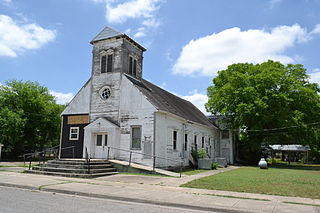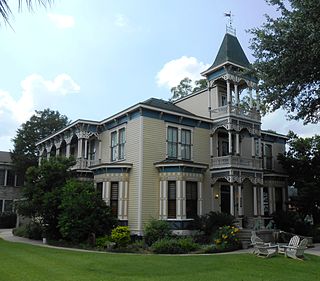Related Research Articles

Cuero is a city in and the county seat of DeWitt County, Texas, United States. Its population was 8,128 at the 2020 census.

The Manhattan Construction Company is an American-owned construction company founded by Laurence H. Rooney in Chandler in Oklahoma Territory in 1896. Today, the firm operates under its parent company, Manhattan Construction Group with affiliates Cantera Concrete Co. and Manhattan Road & Bridge. Manhattan Construction Group is recognized by Engineering News-Record as a top general builder, green builder and bridge builder in the nation. In 2013 and 2012 Manhattan has received more than 50 industry honors for quality and safety. The company's services include "Builder-Driven Pre-Construction", construction management, general building, design-build and turn-key projects, and roads, bridges and civil works. The company works in the U.S., Mexico, Central America and the Caribbean. Not to be confused with Manhattan Construction of Durham Region.
These historic properties and districts in the state of Texas are listed in the National Register of Historic Places. Properties and/or districts are listed in most of Texas's 254 counties.

The East End Historic District encompasses a large 19th-century residential area in eastern Galveston, Texas. The area is roughly bounded by Broadway to the south, Market St to the north, 19th St to the west, and 9th street to the east. The area has one of the best-preserved and largest concentrations of 19th-century residential architecture in Texas. It was developed mainly at a time when Galveston was the state's preeminent port. The historic district, designated locally in 1970, was placed on the National Register of Historic Places in 1975 and declared a National Historic Landmark in 1976.
A Mississippi Landmark is a building officially nominated by the Mississippi Department of Archives and History and approved by each county's chancery clerk. The Mississippi Landmark designation is the highest form of recognition bestowed on properties by the state of Mississippi, and designated properties are protected from changes that may alter the property's historic character. Currently there are 890 designated landmarks in the state. Mississippi Landmarks are spread out between eighty-one of Mississippi's eighty-two counties; only Issaquena County has no such landmarks.
Burns House may refer to:
Keller House may refer to:

Macedonia Baptist Church is a historic church at 512 S. Indianola in Cuero, Texas.

Charles L. Thompson and associates is an architectural group that was established in Arkansas since the late 1800s. It is now known as Cromwell Architects Engineers, Inc.. This article is about Thompson and associates' work as part of one architectural group, and its predecessor and descendant firms, including under names Charles L. Thompson,Thompson & Harding,Sanders & Ginocchio, and Thompson, Sanders and Ginocchio.

The Warren County Courthouse is located in Indianola, Iowa, United States. The courthouse that was built in 1939 was listed on the National Register of Historic Places (NRHP) in 2003 as a part of the PWA-Era County Courthouses of IA Multiple Properties Submission. It was the third building the county has used for court functions and county administration. The building was demolished in the summer of 2019 and removed from the NRHP in September of the same year. A new courthouse and justice center is expected to be completed in 2022.

Julius Carl "Jules" Leffland was a Danish-born architect known for his work in Victoria, Texas, and throughout South Texas. He was active in South Texas from approximately 1886 until the 1910s. Many of his works are listed on the National Register of Historic Places.

Albert John Gibson was one of the most prominent and well-known architects in Missoula, Montana who designed a number of buildings that are listed on the National Register of Historic Places.

The Guenther House is a restaurant, museum and store located at 205 E. Guenther Street in the King William neighborhood of the Bexar County city of San Antonio in the U.S. state of Texas. Currently operated by C. H. Guenther and Son. Inc., the home was originally built as a private residence in 1859 by Pioneer Flour Mills founder Carl Hilmar Guenther. It was listed on the National Register of Historic Places listings in Bexar County, Texas on October 11, 1990.

The Cuero Commercial Historic District in Cuero, Texas is a 21-acre (8.5 ha) historic district that was listed on the National Register of Historic Places in 1988. It includes multiple works of architect Jules Leffland. The listing included 59 contributing buildings.

The D. H. Regan House at 507 S. DeLeon in Victoria, Texas, United States, is an Italianate architecture home designed by architect Jules Leffland. It was built in 1880. It was listed on the National Register of Historic Places in 1986.

Eugene Thomas Heiner was an American architect who designed numerous courthouses, county jails, and other public buildings in Texas. He was born in New York City, apprenticed in Chicago, and studied further in Germany. His works includes buildings listed on the U.S. National Register of Historic Places.

James J. Baldwin (1888–1955), commonly known as J.J. Baldwin, was an American architect who designed numerous courthouse buildings and other works in several U.S. states. His most spectacular work is the Cherokee County Courthouse located in the farthest west corner of North Carolina.
Patrick Henry Weathers, commonly known as P.H. Weathers, was an American architect of Jackson, Mississippi.
The Illinois Steel Bridge Company was an American manufacturer of bridges based in Jacksonville, Illinois. It is credited as builder of a number of bridges and other structures that are listed on the National Register of Historic Places.

Witt, Seibert & Halsey was an American architectural firm based in the twin cities of Texarkana, Arkansas and Texarkana, Texas, with a practice extending into Arkansas, Louisiana and Texas. It was founded by architect Sidney Stewart, but achieved prominence under Bayard Witt and Eugene C. Seibert.
References
- 1 2 David Moore (July 1986). "National Register of Historic Places Inventory-Nomination: The Historic Resources of Cuero, Texas (Partial Inventory of Architectural and Historic Properties)". National Park Service.
- 1 2 3 4 Let's Hear It: Stories by Texas Women Writers, p. 100.
- ↑ "Venerable old span near Mount Bonnell to become foot bridge". Austin American-Statesman. November 26, 1994. p. B1.
- 1 2 3 4 5 6 7 8 9 10 11 12 "National Register Information System". National Register of Historic Places . National Park Service. July 9, 2010.
- ↑ "DeWitt County Museum". Cuero Chamber of Commerce. Archived from the original on 2011-03-15.